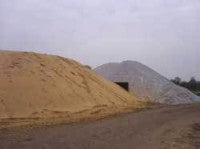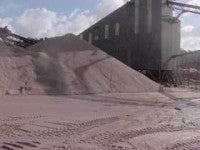Sand and its place at the heart of all sporting surfaces.
Sand and its place at the heart of all sporting surfaces.
A technical paper by Andy Law, M.D. Whitemoss Amenities Ltd

Sand:
Defined as an Inorganic Mineral Fraction between 2.0mm ( 2000microns) and 0.063mm (63microns) or at least in the UK.
The USGA say pretty much the same where the Mineral Fraction falls between 2mm and 0.053mm.
To break this fraction down in more easily understood figures, we see the following:-
Very Coarse Sand 2mm - 1mm (2000 - 1000 microns)
Coarse Sand 1mm - 0.5mm (1000 - 500 microns)
Medium Sand 0.5mm - 0.25mm ( 500 - 250 microns)
Fine Sand 0.25mm - 0.125mm (250 - 125 microns)
Very Fine Sand 0.125mm - 0.063mm (125 - 63 microns)
Above 2000 microns, 2mm, is considered as grit and then gravel. Below 0.063mm, 63 microns is considered silt and then clay particles.

The type, colour and grading is obviously dependant upon the intended use and this is why for the purpose of this paper I am concentrating on Sands for Root Zones, Top Dressings and Bunkers.
I shall hopefully clarify the importance of consistency of grading and organic materials where applicable, throughout the selection of root zone as the growing media and onto top dressings for the longer term maintenance of the surface.
In terms of the selection of the sand, which at all times should be the starting point for any project manager, I shall cover relevant particle size, shape and the relevance and meaning of the " D " numbers which still seem to bring a glazed look to many Heads expressions.
So where do we begin, well lets start by dispelling the myth over the colour of sand telling us its right or wrong for the job.
Colour is not relevant when it comes to specification of suitable sand. Sand is a naturally occurring mineral and quite simply it varies in colour throughout most quarries, indeed I have been in quarries who have 4 differing colours of mineral throughout their resource.
Generally speaking, the lighter the sand the fewer impurities it has, however, this has no effect on its ability to grow grass!
Sand Selection:
Ok so you are about to go into a period of rebuilding your old push up greens, you have been in contact with your architect, got the plans and somehow extracted the funds from the club and got the go ahead with the main instruction from the committee ringing in your ears "minimal disruption to play".
Whats next then?
Well either appoint an agronomist to write a specification for material to be used by the appointed contractor or get hold of a copy of USGA guide to putting green construction.

This should be sent to a recognised laboratory and either ETL or STRI would be suitable establishments for the testing required.
Once your laboratory has established the parameters of the final mix, i.e. particle size ( and tolerance), ph, organic content, total porosity, capillary porosity and non capillary porosity and the D90 / D10 Uniformity figures, these results should be passed to your supplier for him to accept and abide by.
At this point you should consider, do I want USGA specification greens or do I want to match the remaining greens structure but improve them via the use of a drainage layer?
Most quarries will be happy to oblige you in matching up with the particle size of your existing root zone material.
Ok so we better explain some of the terms we mentioned above:-
Particle size and ph I think we can pass over. Organic content is quite important as it's the quickest check to ensure consistency in conjunction with particle size analysis. This test is usually carried out by such as ETL in 2-3 days whereas a full USGA test takes upto a full working week. Generally speaking, so long as the particle size and the organic content remain consistent with the sample originally submitted and accepted, the root zone should be ok in all other respects.
Total Porosity is defined as the pore space which is filled with air and / or water and this does account for between 35 and 55% of the material depending on texture and structure and effected by compaction and consolidation.
Non Capillary Porosity (air filled) is the amount of pore space occupied by air. This is usually recommended to be between 15 and 30% of the total property of the mix.
Capillary Porosity (water filled) is the amount of pore space occupied by water, this is usually advised to be between 15 and 25%.
When the capillary porosity is below 15% the root zone can become very "droughty" and in extreme cases can become very difficult to re wet. When you consider that a root zone does not move water through to the blinding layer and drainage carpet until it is itself at saturation point, this is perhaps one of the more critical figures to consider.
This figure can be effected by long term storage and exposure to prolonged dry weather without further irrigation of the mix to keep the overall moisture content consistent. Storing the root zone delivered to site on top of an area of sandy soil can also result in significant loss of moisture from the mix due the ground beneath sucking the moisture through it. Remember, percolation rate, the speed which water moves through a root zone is dramatically increased the deeper the root zone is placed. If you store a 5 foot pile of root zone over topsoil which is 3 foot deep you have up to 8 feet of hydraulic pull drawing moisture from the root zone.
Root zone received on to your project should ideally be stored for a s short a period as possible and always on a hard standing area.
And now for the D90 and D10 figures.
D value is simply the particle size diameter at which a given cumulative percentage of material is indicated to pass. e.g. If D90 = 650 microns this would indicate that 90% of the material is smaller than 650 microns (0.65mm). And so the D10 is the cumulative percentage which is indicated to pass through a given size. i.e. D10 of 187 shows that 10% of particles of the mix are smaller than 187 microns.
Uniformity is calculated thus D90 650
D10 187
In this example the Uniformity figure would be 3.475 which is a high figure and indicated a broad range of particle distribution. A sand / root zone like this would result in poor drainage and would lead to compaction problems as the particles inter-pack and reduce available air and capillary pore space.

An ideal figure would be 2.3 to 2.5.
A traditional medium dominated sand/ root zone would indicate a D90 of around 475 microns and a D10 of around 190 which would give a uniformity figure of. 2.5 and the figure to the left is represented of a uniform sand particle grading.
This type of sand would be resistant to inter-packing and would more easily resistant compaction problems. The figure also indicates a good total porosity area for both air and water to find its way. This gives the plant plenty of room to grow into.
So to summarise:-
Always ensure that you have materials checked prior to use and on a regular basis during your continued usage of the products. All good suppliers have their own laboratories, however, it is recommended that an independent laboratory is used to ensure accurate results.
Ensure that the sand selected for the growing medium ( root zone) is consistent and available for the long term. This not only ensures a consistent profile, it also saves you the hassle of having to find another suitable supplier in a year or two.
Where possible make sure your root zone supplier can supply you with the exact same mix in a top dressing, i.e. the same grade of sand and the same organic material, screened and heat treated to apply as a light dressing to you greens.
Remember that if you decide to use a medium coarse (USGA) type root zone, you cannot simply continue to use a medium fine dressing. This will very quickly block the surface pores resulting in poor surface drainage and complaints from your members. Always ensure you put onto is a match for what you put into, be it a green a tee or a soccer/rugby pitch.
Particle shape is perhaps a subject on its own as is bunker sand selection. That said its widely regarded that for dressing and root zone use a round to sub rounded shape is most suitable and where readily available these sands should be used.
I am not going to attempt to discuss bunker sand selection other than to say that it is wise to try and ensure that the sand selected for green side bunkers is the same or very similar particle size to the sand selected for the root zone in the greens.
Lastly, seek help and advise from professional suppliers, the BTRMA is a great place to start. With eleven members currently in the association, they represent the vast majority of the root zone and top dressing manufacturers in the U.K.
